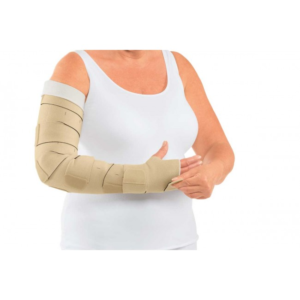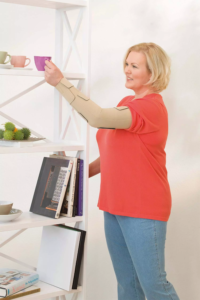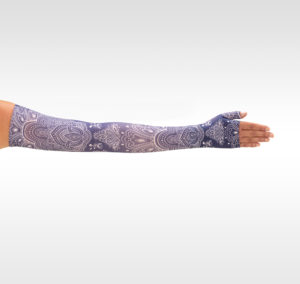Compression garment sleeves shows up in two different forms in lymphedema treatment.
It plays an important role in the reduction phase. This is when we try to get your arm as close to its normal size as possible. This traditionally was done with foams and bandages. More recently, velcro wraps have come into being to help. These are more expensive; however they give more autonomy by allowing the person wearing them to put them on, take them off and even adjust them as necessary by themselves. The traditional reduction phase was called the intensive as it involved daily massage so that your therapist could rebandage the arm.
The secondary role they play is as a maintenance sleeve. This sleeve is thinner than the reduction compression. It is basically a material container that does not allow the arm to get bigger; however, it does not have the capacity to make your arm smaller. Below I will describe a few different options and their pros and cons. This way you have information to decide which is the better path for you at the moment.
Below is a comparison of some of the compression garment sleeves available in the market.
medi circaid Reduction Kit

This kit is medi’s answer to traditional bandages. I wear this on my arms when I fly. It is good because it has the capacity to get smaller with you. The velcro is not sewn on the garment so that as your arm reduces in size the straps can be cut down. The circaid systems have a tension/pressure card that allows you to make sure that you do not create a tourniquet which would make your arm/hand get bigger below it. It is currently the only velcro system that I am aware of that has been scientifically studied and shown to have positive results. Refer to the video as to how to put it on. Personally, I find it a little finicky. Although I’ve been able to put it on myself, it isn’t the easiest system.
medi circaid Juxtalite essentials

This kit is medi’s answer to traditional bandages. I wear this on my arms when I fly. It is good because it has the capacity to get smaller with you. The velcro is not sewn on the garment so that as your arm reduces in size the straps can be cut down. The circaid systems have a tension/pressure card that allows you to make sure that you do not create a tourniquet which would make your arm/hand get bigger below it. It is currently the only velcro system that I am aware of that has been scientifically studied and shown to have positive results. Refer to the video as to how to put it on. Personally, I find it a little finicky. Although I’ve been able to put it on myself, it isn’t the easiest system.
L&R ready wrap

Traditional custom flat knit arm sleeve

Flat knit is the gold standard in maintenance of lymphedema. These garments are custom made to your size no matter what the shape. However, these do not help to make your arm smaller, but to keep it the size it is. I like medi as they will allow for a little bit of reduction unlike other brands. L&R does have a ready made version that is much cheaper and is a good option if your arm measures exactly to their measurements. This is usually the end goal after the reduction phase is complete. While many people worry about the heat I can say that I wore full pantyhose by medi while living in Southern Taiwan for 2 years; while I was warm, so was everyone else. Medi uses moisture wicking material that helps with the heat.
Ready made circular knit arm sleeve

At FLOW we will find the best fit for your needs. Contact our compression garment fitters Leslie or Melissa for more information.
Melissa Krull is a compression garment fitter, registered massage therapist and co-founder of FLOW Lymphatic Health Services.